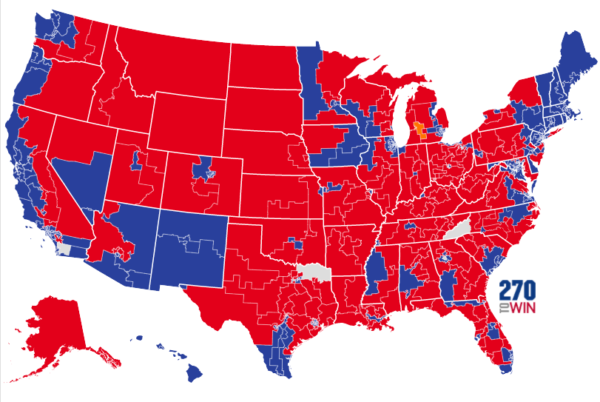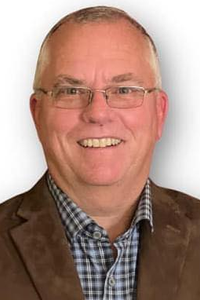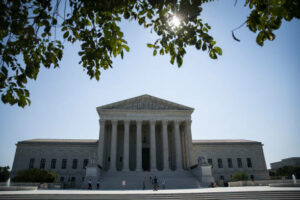American political divisiveness and partisanship often originate with one fact, the age divide. Americans making up older generations including the Greatest Generation and Baby Boomers are much more likely to be Conservative than their younger counterparts. Conversely, members of younger generations including Generation X, Millenials, and Generation Z are more likely to be ideologically Liberal. What has caused this split in philosophy? Why are parents more likely to be ideologically Conservative while their children are more likely to be the opposite? And above all, what factors have contributed to this overall shift in political belief? The answer to these questions likely lies in cultural and demographic shifts that have occurred in the last fifty years. So let’s dive into the age divide in politics to define the origins of its existence.
The Ideology of Demographic Shifts
America today is more diverse than at any other time in its history. Recent census results from 2020 found that White Caucasians make up less than 60% of the United States’ inhabitants. Diversity traditionally brings differences of opinions as to the best way to move forward as a country. For the U.S., diversity has spawned a solid liberal block of thought. Immigrants and their families are more likely to believe in Multiculturalism and the importance of diversity than their white counterparts. These issues are generally championed by those with a liberal ideologically and usually not by those with conservative beliefs. The result of expanding opinions is a younger electorate that believes in those who champion the issues they care about. In this case, it would be the Democratic Party with their belief that immigrants are what makes America great.
On the other hand, ideologically conservative Americans have a somewhat middling view of multiculturalism and the expansion of diversity. A 2018 study conducted by Pew Research Center found that among four generations of Americans (Silent, Boomer, Generation X, and Millenial), the generations that were least likely to say immigrants strengthen the country were in fact the Silent Generation (Greatest Generation) and Baby Boomers. 47% of the Silent Generation said immigrants would strengthen the country while 56% of Baby Boomers said the same. This would include Americans aged 54-90, people that are overwhelming Caucasian compared to younger generations. The study proved that older Americans see the demographics of the past (around 80% white 50 years ago) as a strength rather than a weakness. Additionally, they see diversity as either unnecessary or negative to the current country and its future. The question then becomes, why do they believe this?
The answer is likely the current political climate in America. Many members of the Silent Generation and Baby Boomer Generation view the leftward shift of the Democratic Party as detrimental to the future of America. This would especially include older white Americans. When those with a Liberal ideology advocate for issues such as kneeling for the National Anthem and allowing many thousands of immigrants into the country, these older Americans take pause.
When they go further and advocate for equity over equality, many older citizens see this as reverse discrimination. Whether or not this is true is irrelevant to what the Greatest Generation and Baby Boomers actually believe. Many of these citizens grew up in traditional households with traditional beliefs. These beliefs have not gone away even if one political party has dismissed them and the other is on the verge of doing the same. This ideology is immovable, and so long as the older generations are alive, they will continue to propagate it.
It is also important to note that the same Pew Research study found that members of Generation X and the Millennial Generation saw immigrants as overwhelming strengthening the country. For Generation X, 66% of people said that immigration was benefiting the country. An even larger majority (79%) of Millenials said the same. Clearly, these individuals believe that immigrants are a core constituency of the United States.
This again parallels with Liberal ideology in that those with these beliefs generally advocate for immigrant rights and protections. This is in fact a highly debatable issue with those making up older generations in the United States as well. Many members of the Silent Generation, as well as Baby Boomers, have leaned on their Conservative beliefs which say that immigrants can help the country, but there needs to be a set number allowed to enter the U.S. and an even smaller number that are allowed to become citizens.
The Ideology of Traditional Beliefs
As previously alluded to, traditional beliefs (or lack thereof) account for a vast swathe of the age divide in politics. Since the beginning of the Greatest Generation all the way through the 1980s, many Americans believed a few core beliefs. First, working hard and starting a family was the objective of nearly every man and woman in the United States. Second, attending church services and being religious was the moral background of America and was what most individuals strived for.
And lastly, avoiding profanity and projecting the best possible face in every situation was the ideal facade. Traditional beliefs obviously go well behind these highlighted issues, but many can be traced back to these three things: family, religion, and respect. These are the beliefs that many in the older generations that make up America believe govern their lives. Additionally, this is what many in the Greatest Generation and in the Baby Boomer Generation strive for.
These traditional beliefs started to lose steam as the 1990s began. Americans became less likely to start a family, less likely to go to church, and less likely to avoid profanity. President Bill Clinton’s indiscretions did not help matters either as Americans saw that even the President engaged in immoral behavior. While this was far from the only reason traditional families, religion, and respect became less important, it essentially marks the beginning of the slow decline in all of these institutes of belief.
For religion specifically, the decline is particularly precipitous. According to a Gallup Poll released in 2019, church attendance fluctuated between 66% and 76% between 1938 and 1998. But since then, attendance has declined to just 50% in 2018. Further studies showed an even lower average attendance rate for Americans going to church since that time. This decline is partly responsible for the age divide in politics in that those who call themselves religious are much more likely to be ideologically Conservative than those who are not.
The same Gallup study showed that between 1998 and 2000, 90% of Americans said they were affiliated with a religion. Just 10% said they were affiliated with no religion or declined to respond to the survey. In other words, 22 years ago, 9 out of every 10 people were at the very least religious enough to classify themselves as a member of a religious sect. By contrast, the study showed that between 2016 and 2018, only 77% of people said they affiliated with a religion. The number that affiliated with no religion or refused to answer the survey rose to 23%, with 19% expressly stating they did not identify with any religion.
This poll proves that Americans over the last 25 years have become less religious as a whole. And as a result, they are becoming less Conservative since religiousness often goes hand and hand with Conservative ideology. And what is driving this decline in devoutness? The same thing that is driving an overwhelmingly positive opinion of immigration: young people. Young people are much more likely to avoid attending religious services and classify themselves as nonreligious. This in turn has caused younger individuals to view the traditional beliefs that many religions advocate for as simply unimportant.
The Ideology of Evolving Priorities
The essential question when it comes to the age divide in politics is why have younger people as a whole become more Liberal while their parents in many cases have remained Conservative? The answer is often changing priorities. As mentioned before, the older generations that make up America such as the Greatest Generation and the Baby Boomer Generation valued family, religion, and respect. The younger generations including Generation X, Millenials, and Generation Z have very different priorities overall. Instead of starting a family, many young people fresh out of high school want to attend college and subsequently attain a high-earning job. The need for the latter becomes even more apparent when the average student accumulates around $30,000 in student debt according to US News.
So in many cases, even if a young person wanted to start a family, they couldn’t because of crushing debt. Instead, they go directly into the workforce and work laborious jobs right through their twenties. For example, in 1980, the average man got married at 24 years old while the average woman got married at 22. Thirty years later, men on average were getting married at 28 years old while women were taking vows at 26. In other words, people are now waiting up to 6 years after they graduate college to get married. Why, because they can not afford to take vows and start a family straight out of college and they are prioritizing work over family regardless.
The second arm of traditional beliefs gone awry is religion. As previously mentioned, people are becoming less religious and attending church in much lower numbers than they ever have before. But it is important to note that many Americans making up older generations are still attending church in plentiful numbers. The overall decline in church attendance is being fueled by very low religious interest from Millenials and Gen Zers. According to the Pew Research survey, only 29% of Millenials say that belief in God is necessary to be moral.
On the other hand, over 62% of the Silent Generation say this belief in God is important. Again, this is where priorities come into play. Younger people on average see religion and attending church as unnecessary to fulfilling their moral obligations. Moreover, young people do not see God as the end all be all the way previous generations did. Lastly, these people have turned to media that promotes immorality and focuses on individuals’ well-being irrespective of religion.
On the subject of media, the final traditional belief that has shifted in importance comes to light. That would be respect, and specifically the avoidance of profanity and promiscuity in popular culture. It is no coincidence that the ideological shift from Conservative to Liberal beliefs over the past 50 years finds its roots in the media. The media controls culture, perceived societal norms, and frankly the mood of the entire country. Movies and TV shows in the last 30 to 40 years have glorified violence, drugs, and sex. They have propagated promiscuity and normalized it to the point where normal people see it as acceptable behavior.
Whether or not you agree with this is irrelevant, but almost everyone can agree that most media includes some form of illicit behavior. Furthermore, media giants prey on people’s emotions through content that glorifies this behavior and in some cases even encourages it. OnlyFans (a soft pornography website used by children in many cases) is an example of this. The young people that consume this content on a daily basis are the ones most influenced by it. They see what media companies want them to see and adopt it as their own behavior. The result is an entire generation of people who do not value family, religion, or respect.
The Ideology of Age
We can trace back the age divide in politics to a lot of factors. This includes cultural and demographic shifts, the abandonment of traditional beliefs, and the evolving priorities of many young people. But what it really all comes back to is influence and politics. The influence is provided by families, friends, and above all media. Politics is injected into every level of popular culture by way of the current partisan climate in the United States.
Moreover, those who wish to split families in half along age lines by propagating divisiveness are summarily getting their way. The age divide really has nothing to do with age at all, it has to do with influence. The influence of 50 years of immigration, the influence of 50 years of leaving traditional beliefs in the dust, and the influence of 50 years of shapeshifting ideological priorities. The United States of America is indeed divided along age lines, but its relation to age is in name only.







